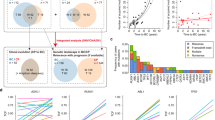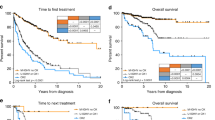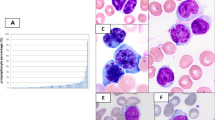Abstract
Activation-induced cytidine deaminase (AID) is essential for somatic hypermutation of B-cells. We investigated the expression of AID mRNA by real-time polymerase chain reaction (PCR) in peripheral blood mononuclear cells of 80 patients with B-CLL. AID expression was detected in 45 of 80 patients (56%) at various levels, but was undetectable in 35 patients (44%). AID PCR positivity was associated with unmutated IGVH gene status (22 of 25 patients; P=0.002) and unfavourable cytogenetics (18 of 23 patients with deletion in 11q or loss of p53; P=0.040). Using a threshold level of 0.01-fold expression compared to Ramos control cells, even more significant associations were observed (P=0.001 for IGVH; P=0.002 for cytogenetics). A correlation was observed between individual AID levels and the percentage of VH homology (R=0.41; P=0.001). AID positivity predicted unmutated IGVH status with an odds ratio of 8.31 (P=0.003) and poor risk cytogenetics with an odds ratio of 3.46 (P=0.032). Significance was retained after adjustment for Binet or Rai stages. AID mRNA levels were stable over time. These data suggest a potential role of AID as a prognostic marker in B-CLL.
This is a preview of subscription content, access via your institution
Access options
Subscribe to this journal
Receive 12 print issues and online access
$259.00 per year
only $21.58 per issue
Buy this article
- Purchase on Springer Link
- Instant access to full article PDF
Prices may be subject to local taxes which are calculated during checkout



Similar content being viewed by others
References
Rai KR, Sawitsky A, Cronkite EP, Chanana AD, Levy RN, Pasternack BS . Clinical staging of chronic lymphocytic leukemia. Blood 1975; 46: 219–234.
Binet JL, Lepoprier M, Dighiero G, Charron D, D'Athis P, Vaugier G et al. A clinical staging system for chronic lymphocytic leukemia: prognostic significance. Cancer 1977; 40: 855–864.
Rozman C, Montserrat E . Chronic lymphocytic leukemia. N Engl J Med 1995; 333: 1052–1057.
Kipps TJ . Chronic lymphocytic leukaemia. Curr Opin Hematol 2000; 7: 223–234.
Montserrat E, Sanchez-Bisono J, Vinolas N, Rozman C . Lymphocyte doubling time in chronic lymphocytic leukaemia: analysis of its prognostic significance. Br J Haematol 1986; 62: 567–575.
Reinisch W, Willheim M, Hilgarth M, Gasche C, Mader R, Szepfalusi S et al. Soluble CD23 reliably reflects disease activity in B-cell chronic lymphocytic leukemia. J Clin Oncol 1994; 12: 2146–2152.
Hallek M, Langenmayer I, Nerl C, Knauf W, Dietzfelbinger H, Adorf D et al. Elevated serum thymidine kinase levels identify a subgroup at high risk of disease progression in early, nonsmoldering chronic lymphocytic leukemia. Blood 1999; 93: 1732–1737.
Heintel D, Schwarzinger I, Chizzali-Bonfadin C, Thalhammer R, Schwarzmeier J, Fritzer-Szekeres M et al. Association of CD38 antigen expression with other prognostic parameters in early stages of chronic lymphocytic leukemia. Leuk Lymphoma 2001; 42: 1315–1321.
Dohner H, Stilgenbauer S, Benner A, Leupolt E, Krober A, Bullinger L et al. Genomic aberrations and survival in chronic lymphocytic leukemia. N Engl J Med 2000; 343: 1910–1916.
Dohner H, Stilgenbauer S, James MR, Benner A, Weilguni T, Bentz M et al. 11q deletions identify a new subset of B-cell chronic lymphocytic leukemia characterized by extensive nodal involvement and inferior prognosis. Blood 1997; 89: 2516–2522.
Hamblin TJ, Davis Z, Gardiner A, Oscier DG, Stevenson FK . Unmutated Ig V(H) genes are associated with a more aggressive form of chronic lymphocytic leukemia. Blood 1999; 94: 1848–1854.
Damle RN, Wasil T, Fais F, Ghiotto F, Valetto A, Allen SL et al. Ig V gene mutation status and CD38 expression as novel prognostic indicators in chronic lymphocytic leukemia. Blood 1999; 94: 1840–1847.
Hamblin TJ, Orchard JA, Ibbotson RE, Davis Z, Thomas PW, Stevenson FK et al. CD38 expression and immunoglobulin variable region mutations are independent prognostic variables in chronic lymphocytic leukemia, but CD38 expression may vary during the course of the disease. Blood 2002; 99: 1023–1029.
Oscier DG, Gardiner AC, Mould SJ, Glide S, Davis ZA, Ibbotson RE et al. Multivariate analysis of prognostic factors in CLL: clinical stage, IGVH gene mutational status, and loss or mutation of the p53 gene are independent prognostic factors. Blood 2002; 100: 1177–1184.
Krober A, Seiler T, Benner A, Bullinger L, Bruckle E, Lichter P et al. V(H) mutation status, CD38 expression level, genomic aberrations, and survival in chronic lymphocytic leukemia. Blood 2002; 100: 1410–1416.
Thunberg U, Johnson A, Roos G, Thorn I, Tobin G, Sallstrom J et al. CD38 expression is a poor predictor for VH gene mutational status and prognosis in chronic lymphocytic leukemia. Blood 2001; 97: 1892–1894.
Stilgenbauer S, Bullinger L, Lichter P, Dohner H, German CLL Study Group (GCLLSG). Chronic lymphocytic leukemia. Genetics of chronic lymphocytic leukemia: genomic aberrations and V(H) gene mutation status in pathogenesis and clinical course. Leukemia 2002; 16: 993–1007.
Tobin G, Thunberg U, Johnson A, et Thorn I, Soderberg O, Hultdin M et al. Somatically mutated Ig V(H)3–21 genes characterize a new subset of chronic lymphocytic leukemia. Blood 2002; 99: 2262–2264.
Guarini A, Gaidano G, Mauro FR, Capello D, Mancini F, De Propris MS et al. Chronic lymphocytic leukemia patients with highly stable and indolent disease show distinctive phenotypic and genotypic features. Blood 2003; 102: 4497–4506.
Rosenwald A, Alizadeh AA, Widhopf G, Simon R, Davis RE, Yu X et al. Relation of gene expression phenotype to immunoglobulin mutation genotype in B cell chronic lymphocytic leukemia. J Exp Med 2001; 194: 1639–1647.
Chen L, Widhopf G, Huynh L, Rassenti L, Rai KR, Weiss A et al. Expression of ZAP-70 is associated with increased B-cell receptor signaling in chronic lymphocytic leukemia. Blood 2002; 100: 4609–4614.
Wiestner A, Rosenwald A, Barry TS, Wright G, Davis RE, Henrickson SE et al. ZAP-70 expression identifies a chronic lymphocytic leukemia subtype with unmutated immunoglobulin genes, inferior clinical outcome, and distinct gene expression profile. Blood 2003; 101: 4944–4951.
Crespo M, Bosch F, Villamor N, Bellosillo B, Colomer D, Rozman M et al. ZAP-70 expression as a surrogate for immunoglobulin-variable-region mutations in chronic lymphocytic leukemia. N Engl J Med 2003; 348: 1764–1775.
Rai KR, Chiorazzi N . Determining the clinical course and outcome in chronic lymphocytic leukemia. N Engl J Med 2003; 348: 1797–1799.
Muramatsu M, Sankaranand VS, Anant S, Sugai M, Kinoshita K, Davidson NO et al. Specific expression of activation-induced cytidine deaminase (AID), a novel member of the RNA-editing deaminase family in germinal center B cells. J Biol Chem 1999; 274: 18470–18476.
Jacobs H, Bross L . Towards an understanding of somatic hypermutation. Curr Opin Immunol 2001; 13: 208–218.
Martin A, Scharff MD . Somatic hypermutation of the AID transgene in B and non-B cells. Proc Natl Acad Sci USA 2002; 99: 12304–12308.
Oppezzo P, Vuillier F, Vasconcelos Y, Dumas G, Magnac C, Payelle-Brogard B et al. Chronic lymphocytic leukemia B cells expressing AID display a dissociation between class switch recombination and somatic hypermutation. Blood 2003; 101: 4029–4032.
Cerutti A, Zan H, Kim EC, Shah S, Schattner EJ, Schaffer A et al. Ongoing in vivo immunoglobulin class switch DNA recombination in chronic lymphocytic leukemia B cells. J Immunol 2002; 169: 6594–6603.
McCarthy H, Wierda WG, Barron LL, Cromwell CC, Wang J, Coombes KR et al. High expression of activation-induced cytidine deaminase (AID) and splice variants is a distinctive feature of poor prognosis chronic lymphocytic leukemia. Blood 2003; 101: 4903–4908.
Albesiano E, Messmer BT, Damle RN, Allen SL, Rai KR, Chiorazzi N . Activation-induced cytidine deaminase in chronic lymphocytic leukemia B cells: expression as multiple forms in a dynamic, variably sized fraction of the clone. Blood 2003; 102: 3333–3339.
Armitage P, Colton T . Encyclopaedia of Biostatistics, Vol. 1 Chichester, UK: John Wiley and Sons, 1998.
Zhang W, Bardwell PD, Woo CJ, Poltoratsky V, Scharff MD, Martin A . Clonal instability of V region hypermutation in the Ramos Burkitt's lymphoma cell line. Int Immunol 2001; 13: 1175–1184.
Greeve J, Philipsen A, Krause K, Klapper W, Heidorn K, Castle BE et al. Expression of activation-induced cytidine deaminase in human B-cell non-Hodgkin's lymphomas. Blood 2003; 101: 3574–3580.
Okazaki IM, Hiai H, Kakazu N, Yamada S, Muramatsu M, Kinoshita K et al. Constitutive expression of AID leads to tumorigenesis. J Exp Med 2003; 197: 1173–1181.
Acknowledgements
We wish to thank Bernd Biermayer for IGVH sequence analysis and Uli Zeman for excellent technical assistance and Zahida Chaudary for documentation of patients enrolled in GCLLSG studies. This work was supported by the Austrian National Bank Grant # 9964, by the Center of Molecular Medicine (CeMM) of the Austrian Academy of Sciences (#20010) (UJ, DH), by Sander Stiftung Grant # 2001.004.1, and by BMBF Grant # 01KW9934 (SS, HD).
Author information
Authors and Affiliations
Consortia
Corresponding author
Rights and permissions
About this article
Cite this article
Heintel, D., Kroemer, E., Kienle, D. et al. High expression of activation-induced cytidine deaminase (AID) mRNA is associated with unmutated IGVH gene status and unfavourable cytogenetic aberrations in patients with chronic lymphocytic leukaemia. Leukemia 18, 756–762 (2004). https://doi.org/10.1038/sj.leu.2403294
Received:
Accepted:
Published:
Issue Date:
DOI: https://doi.org/10.1038/sj.leu.2403294
Keywords
This article is cited by
-
Loss of AID exacerbates the malignant progression of CLL
Leukemia (2022)
-
Activation-induced deaminase and its splice variants associate with trisomy 12 in chronic lymphocytic leukemia
Annals of Hematology (2019)
-
Activation induced deaminase mutational signature overlaps with CpG methylation sites in follicular lymphoma and other cancers
Scientific Reports (2016)
-
Expression of activation-induced cytidine deaminase is associated with a poor prognosis of diffuse large B cell lymphoma patients treated with CHOP-based chemotherapy
Journal of Cancer Research and Clinical Oncology (2016)
-
Whole-genome sequencing reveals activation-induced cytidine deaminase signatures during indolent chronic lymphocytic leukaemia evolution
Nature Communications (2015)



